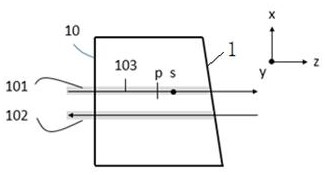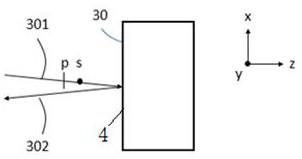Method for optimizing polarization dependent loss
A technology of polarization dependent loss and axis direction, applied in the field of optical communication, can solve the problem of polarization dependent loss of optical filter
- Summary
- Abstract
- Description
- Claims
- Application Information
AI Technical Summary
Problems solved by technology
Method used
Image
Examples
Embodiment Construction
[0020] Example figure 1 As shown, the method for optimizing polarization-dependent loss in the present invention firstly establishes x-axis, y-axis, and z-axis coordinate system, wherein the x-axis and z-axis are parallel to the paper, the y-axis is perpendicular to the outside of the paper, and the input light 103 is in the optical fiber at the input end 101 propagates along the z-axis direction, and becomes incident light 301 with a small angle after passing through the first lens 20. The incident light 301 is reflected by the filter 30 and becomes reflected light 302, which propagates along the -z-axis direction and passes through the first lens 20. A lens 20 is injected into the optical fiber 102 at the reflective end; the incident light 301 passes through the optical filter 30 and becomes transmitted light 401 and continues to propagate along the z-axis direction, and enters the optical fiber 501 at the transmissive end after passing through the second lens 40; wherein, T...
PUM
 Login to View More
Login to View More Abstract
Description
Claims
Application Information
 Login to View More
Login to View More - R&D
- Intellectual Property
- Life Sciences
- Materials
- Tech Scout
- Unparalleled Data Quality
- Higher Quality Content
- 60% Fewer Hallucinations
Browse by: Latest US Patents, China's latest patents, Technical Efficacy Thesaurus, Application Domain, Technology Topic, Popular Technical Reports.
© 2025 PatSnap. All rights reserved.Legal|Privacy policy|Modern Slavery Act Transparency Statement|Sitemap|About US| Contact US: help@patsnap.com



